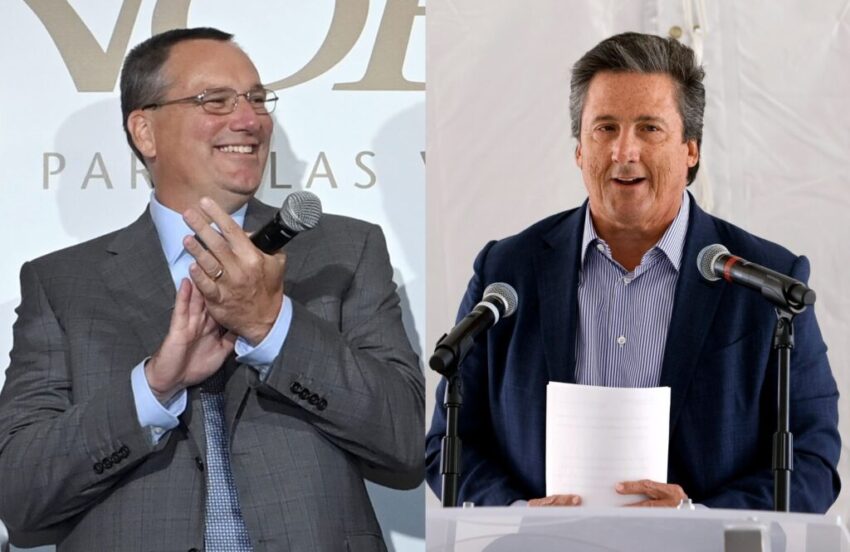Caesars CEO Tom Reeg (left); MGM CEO Bill Hornbuckle. (Reeg photo: David Becker/Getty Images for Caesars Entertainment; Horbuckle photo: Ethan Miller, Getty Images)
A new report criticizes gaming giants Caesars Entertainment and MGM Resorts International for investing more in their CEOs and corporate investors than in supporting the tens of thousands of workers who keep their casinos operating.
The Institute for Policy Studies and Inequality.org each year analyze the 100 S&P 500 corporations with the lowest median worker pay. They’ve dubbed these corporations the Low Wage 100 and highlight the growing disparities between those average workers’ pay and their CEOs.
Only three S&P 500 companies, all gaming giants, are headquartered in Nevada. All three fall within the Low Wage 100.
Caesars CEO Thomas Reeg was compensated $18.4 million in 2024 while the median worker earned $43,880. That translates to a CEO-to-worker pay ratio of 419-to-1.
Put another way: For every $1 the median worker earned, Reeg made $419.
According to their SEC filing, Caesars calculated that median (half make more, half make less) worker salary from its 48,261 full-time, part-time, and seasonal employees, all based in the U.S. Less than 5% of their total workforce is located outside of the U.S. and were excluded from the ratio.
Meanwhile, MGM Resorts CEO William Hornbuckle was compensated $15.8 million last year while the median worker earned $47,607. That translates to a CEO-to-worker pay ratio of 332-to-1.
According to their SEC filing, MGM Resorts employed 76,527 last year, including 13,063 as MGM China. Those figures include full-time, part-time, seasonal, and temporary employees.
Since 2019, Caesars CEO compensation rose 106.4% while its median worker pay rose 40.8%. Reeg has been CEO that entire time. Meanwhile, MGM Resorts CEO compensation rose 20.3% while median worker pay rose 22.2%. Hornbuckle has been CEO for most of that time, securing the corporation’s top spot in July 2020.
Caesars and MGM Resorts are both major employers in Nevada.
The third Nevada-based S&P 500 company, Las Vegas Sands, no longer operates casinos within the state, but its majority shareholder, billionaire Miriam Adelson, remains a powerful figure. Las Vegas Sands paid CEO Robert Goldstein $21.9 million last year and their median worker $42,426.
Adelson is one of at least 32 billionaires who owes their wealth to a Low Wage 100 company, according to the report.
The “Executive Excess” report also compared what each corporation spent on stock buybacks with what was spent on capital expenditures, arguing that the former “creates huge short-term windfalls for executives and shareholders at the expense of workers and long-term productive investments.” Stock buybacks were illegal until 1982.
MGM Resorts last year spent $9.565 billion on stock buybacks, more than double the $4.349 billion it spent on capital expenditures.
Meanwhile, Caesars and Las Vegas Sands spent more on capital expenditures than stock buybacks. Caesars last year spent $4.77 billion in capital expenditures and $191 million on stock buybacks. Las Vegas Sands spent $6.95 billion on capital expenditures and $3 billion on stock buybacks.
Excluding Amazon, whose spending on expansion is an outlier and dwarfs all others on the list, the Low Wage 100 companies collectively spent more on stock buybacks between 2019 and 2025 than they did on capital expenditures.
Across all of the Low Wage 100, average CEO compensation rose 34.7% between 2019 and 2024 while average median worker pay rose 16.3%. Inflation was 22.6% over that same period.
The average CEO total compensation for these companies in 2024 was $17.2 million while average median worker pay was $35,570. That’s a CEO-to-worker pay ratio of 632-to-1.
The report notes that, if the analysis is expanded to all S&P 100 corporations, the CEO-to-worker ratio lowers to 285-to-1. If you go back six decades, to 1965, CEO-to-worker pay was 25 to 1.
Since 2019, Caesars’ CEO pay ratio has expanded 47% and MGM’s has decreased minimally by 1.5%.
“America’s largest low-wage employers continue to fixate on enriching their CEOs at the expense of both their workers and their corporate prospects for long-term growth,” concludes the report.
Non-S&P gaming companies
The “Executive Excess” report only evaluated the largest 500 corporations in the United States. So how do the gaming corporations that fall outside of the S&P 500 fare?
Here are their 2024 CEO pay ratios, as reported on their SEC filings:
- Bally’s Corp: 54-to-1. CEO Robeson Reeves made $2.3 million; the median worker made $41,912.
- Red Rock Resorts, parent company of Station Casinos: 78-to-1. CEO Frank Fertitta made $3.3 million; the median worker made $42,864.
- Golden Entertainment: 155-to-1. CEO Blake Sartini made $5.4 million; the median worker made $34,783.
- Boyd Gaming Corp: 304-to-1. CEO Keith Smith made $11.5 million; the median worker made $37,755.
- Penn Entertainment: 734-to-1. CEO Jay Snowden made $26.6 million; the median worker made $36,322.
Click this link for the original source of this article.
Author: April Corbin Girnus
This content is courtesy of, and owned and copyrighted by, https://www.nevadacurrent.com and its author. This content is made available by use of the public RSS feed offered by the host site and is used for educational purposes only. If you are the author or represent the host site and would like this content removed now and in the future, please contact USSANews.com using the email address in the Contact page found in the website menu.





